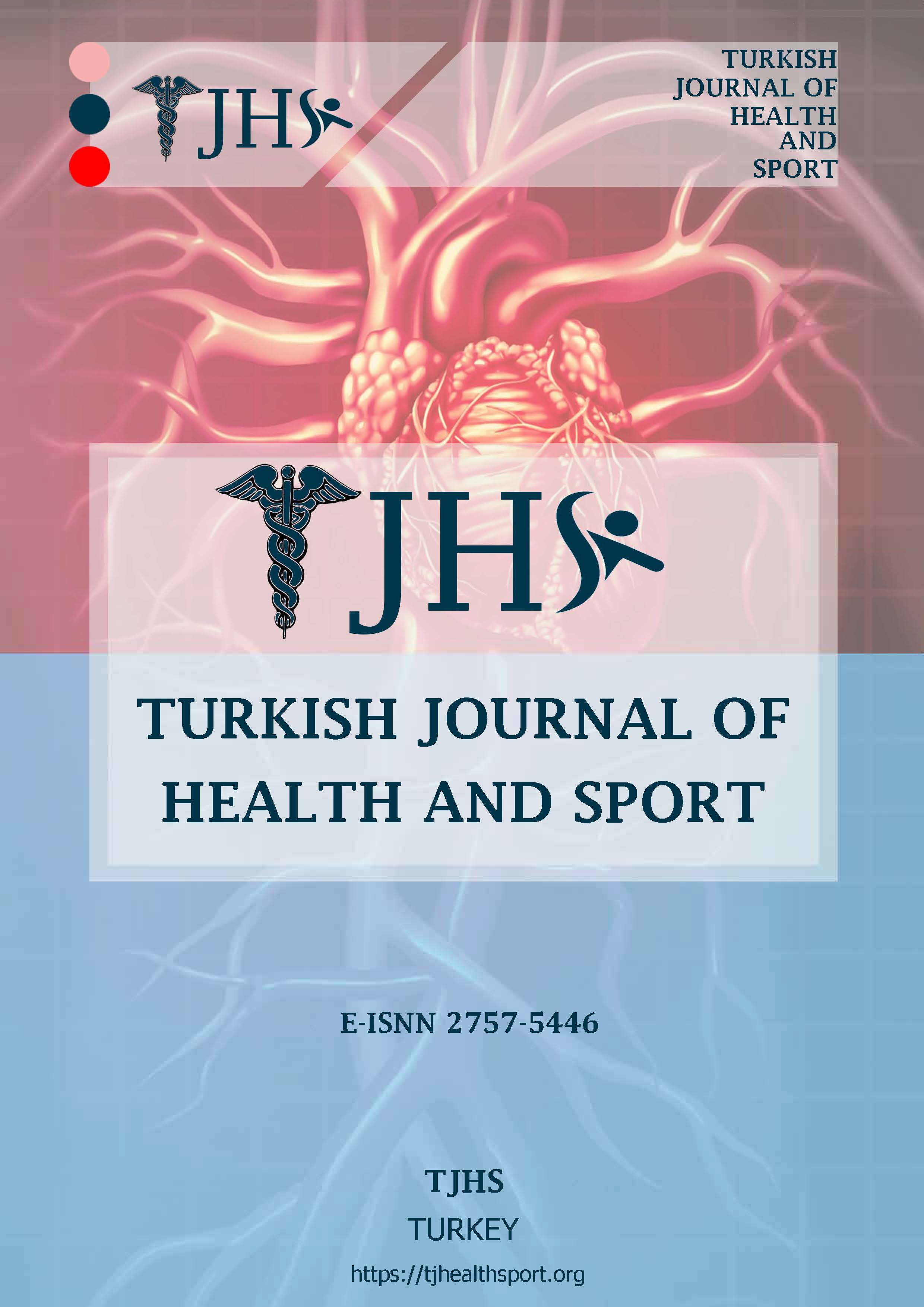Proksimal Humerus Kırığının Cerrahi Olarak Tedavi Edildiği Hastada Artmış Üst Trapezius Kas Aktivitesinin EMG Biofeedback Eğitimi ile Normalize Edilmesi: Olgunun Bir Yıllık Takip Sonuçları
Author :
Abstract
Amaç: Parçalı proksimal humerus kırığının cerrahi olarak tedavi edildiği hastada geleneksel rehabilitasyon
programına dahil edilen elektromiyografi (EMG) biofeedback eğitiminin semptomlar, üst trapezius kas
aktivitesi, fonksiyonel durum ve yaşam kalitesi üzerine bir yıllık sonuçlarını değerlendirmektir.
Yöntem: Hastanın ağrı şiddeti (Görsel Analog Skala), eklem hareket açıklığı (Universal gonyometre), kavrama
kuvveti (Jamar Hidrolik El Dinamometresi), skapular pozisyon (Lateral Skapular Slide Test), hareket korkusu
(Tampa Kinezyofobi Skalası), üst ekstremite fonksiyonel durumu (Kol, Omuz ve El Sorunları Anketi), yaşam
kalitesi (SF-36 Ölçeği), üst trapezius kası aktivitesi (yüzeyel EMG) tedavi öncesi, tedavi sonrası ve bir yıllık
takipte değerlendirildi. Artmış üst trapezius kas aktivitesini normalize etmek için geleneksel rehabilitasyon
programına dahil edilen EMG biofeedback eğitimi sekiz hafta boyunca uygulandı.
Bulgular: Tedavi sonrasında ve bir yıllık takipte ağrı şiddeti ve hareket korkusunun azaldığı, eklem hareket
açıklığı, kavrama kuvveti, üst ekstremite fonksiyonel durumu ve yaşam kalitesinin arttığı bulundu. Ayrıca,
artmış üst trapezius kas aktivitesinin normale döndüğü ve skapula pozisyonundaki asimetrinin azaldığı
görüldü.
Sonuç: Parçalı proksimal humerus kırığının cerrahi olarak tedavi edildiği hastada, EMG biofeedback eğitimini
içeren iyi planlanmış bir rehabilitasyon programı semptomları azaltabilir, fonksiyonel durumu ve yaşam
kalitesini iyileştirebilir.
Keywords
Abstract
Aim: To evaluate the one-year results of the effects of electromyography (EMG) biofeedback training included
in the traditional rehabilitation program on symptoms, upper trapezius muscle activity, functional status, and
quality of life in a patient with surgically treated fragmented proximal humerus fracture.
Method: The patient’s pain severity (Visual Analogue Scale), range of motion (Universal goniometer), grip
strength (Jamar Hydraulic Hand Dynamometer), scapular position (Lateral Scapular Slide Test), fear of
movement (Tampa Kinesiophobia Scale), the functional status of the upper extremity (Disabilities of the Arm,
Shoulder, and Hand Questionnaire), quality of life (SF-36 Scale), upper trapezius muscle activity (surface EMG)
were evaluated before and after the treatment, and at one-year follow-up. The EMG biofeedback training,
which was included in the traditional rehabilitation program, was applied for eight weeks to normalize the
increased upper trapezius muscle activity.
Results: It was found that pain severity and fear of movement were decreased, range of motion, grip strength,
functional status of the upper extremity, and quality of life were increased after the treatment and at oneyear
follow-up. Also, the increased upper trapezius muscle activity was normalized and the asymmetry in the
scapula position was decreased.
Conclusion: A well-planned rehabilitation program, including EMG biofeedback training, can reduce the
symptoms, improve the functional status and the quality of life in a patient with surgically treated fragmented
proximal humerus fracture.
Keywords
- 1. Neer CS. Displaced proximal humeral fractures: Part II. Treatment of three-part and four-part displacement. J Bone Joint Surg. 1970;52(6):1090-103.
- 2. Naranja RJ, Iannotti JP. Displaced three-and four-part proximal humerus fractures: evaluation and management. J Am Acad Orthop Surg. 2000;8(6):373-82.
- 3. Kelley MJ. Anatomic and biomechanical rationale for rehabilitation of the athlete’s shoulder. J Sport Rehabil. 1995;4(2):122-54. https://doi.org/10.1123/jsr.4.2.122
- 4. Paine RM, Voight M. The role of the scapula. J Orthop Sports Phys Ther. 1993;18(1):386-91. https://www. jospt.org/doi/10.2519/jospt.1993.18.1.386
- 5. Morin GE, Tiberio D, Austin G. The effect of upper trapezius taping on electromyographic activity in the upper and middle trapezius region. J Sport Rehabil. 1997;6(4):309-18. https://doi.org/10.1123/jsr.6.4.309
- 6. San Juan JG, Gunderson SR, Kane-Ronning K, Supra DN. Scapular kinematic is altered after electromyography biofeedback training. J Biomech. 2016;49(9):1881-6. https://doi.org/10.1016/j.jbiomech.2016.04.036
- 7. Keefe FJ, Surwit RS. Electromyographic biofeedback: behavioral treatment of neuromuscular disorders. J Behav Med. 1978;1(1):13-24. doi: 10.1007/BF00846583.
- 8. Dones VC, Serra MAB, Kamus GOT, Esteban AC, Mercado AMS, Rivera RGA et al. The effectiveness of biomechanical taping technique on visual analogue scale, static maximum handgrip strength, and patient rated tennis elbow evaluation of patients with lateral epicondylalgia: A cross-over study. J Bodyw Mov Ther. 2019; 23(2):405-16. https://doi.org/10.1016/j.jbmt.2018.05.004
- 9. Curtis T, Roush JR. The lateral scapular slide test: A reliability study of males with and without shoulder pathology. North American Journal of sports physical therapy: N Am J Sports Phys Ther. 2006;1(3):140-6.
- 10. Tunca Yilmaz O, Yakut Y, Uygur F, Ulug N. Turkish version of the tampa scale for kinesiophobia and its test- retest reliability [in Turkish]. Turk J Physiother Rehabil. 2011; 22(1):44-9.
- 11. Duger T, Yakut E, Oksuz C, Yorukan S, Bilgutay BS, Ayhan Ç et al. Reliability and validity of the Turkish version of the disabilities of the arm, shoulder and hand (DASH) questionnaire. Turk J Physiother Rehabil. 2006;17(3):99-107.
- 12. Kocyigit H, Aydemir O, Fisek G, Olmez N, Memis A. Reliability and validity of the Turkish version of form-36 (SF-36) [in Turkish]. Turkish journal of drugs & therapeutics. 1999; 12(2):102-6.
- 13. Ludewig PM, Hoff MS, Osowski EE, Meschke SA, Rundquist PJ. Relative balance of serratus anterior and upper trapezius muscle activity during push-up exercises. Am J Sports Med. 2004;32(2):484-93. https://doi. org/10.1177/0363546503258911
- 14. Cleeland CS. Behavioral technics in the modification of spasmodic torticollis. Neurology. 1973;23(11):1241- 7. https://doi.org/10.1212/WNL.23.11.1241
- 15. Carlsson SG, Gale EN, Öhman A. Treatment of temporomandibular joint syndrome with biofeedback training. J Am Dent Assoc. 1975;91(3):602-5. https://doi.org/10.14219/jada.archive.1975.0420
- 16. Solberg WK, Rugh JD. The use of biofeedback devices in the trKAtment of bruxism. J South Calif Dent Assoc. 1972;40:852-3.
- 17. Ma C, Szeto GP, Yan T, Wu S, Lin C, Li L. Comparing biofeedback with active exercise and passive treatment for the management of work-related neck and shoulder pain: a randomized controlled trial. Arch Phys Med Rehabil. 2011;92(6):849-58. https://doi.org/10.1016/j.apmr.2010.12.037
- 18. Huang HY, Lin JJ, Guo YL, Wang WTJ, Chen YJ. EMG biofeedback effectiveness to alter muscle activity pattern and scapular kinematics in subjects with and without shoulder impingement. J Electromyogr Kinesiol. 2013;23(1):267-74. https://doi.org/10.1016/j.jelekin.2012.09.007





